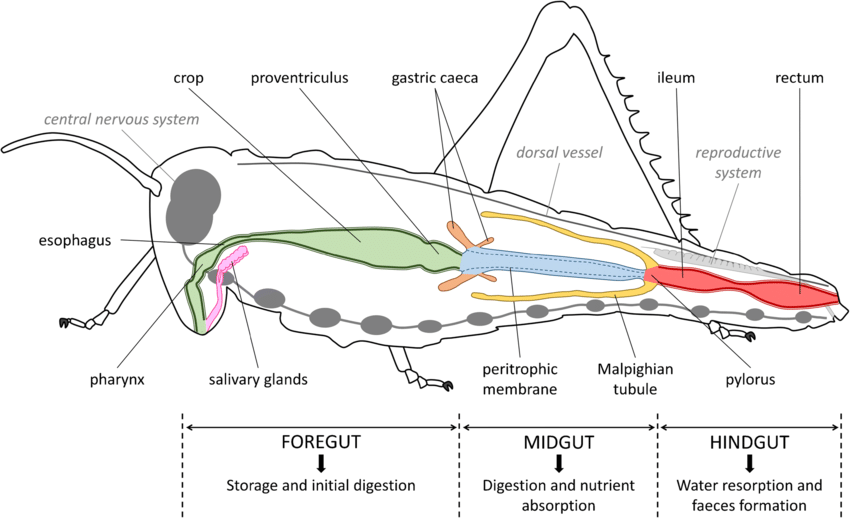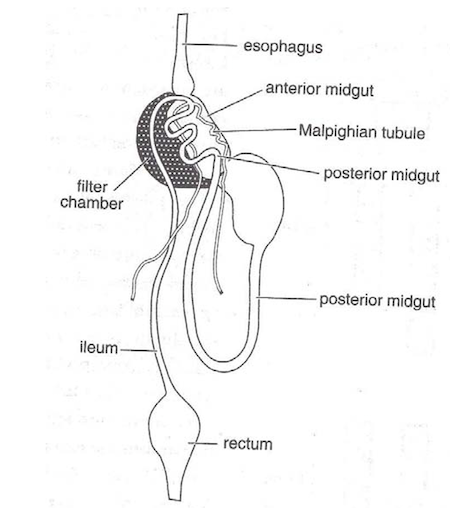🍽️ Digestive System
Stucture and function of alimentary canal of insects, process of digestion and types of insects on the basis of food habits.
Which of the following statment is correct?
- Insects may be phytophagous, entomophagous, wood borers, wool feeders or saprophytic, mainly feeding on the solid food material which may be a plant part (or) host tissue (or) wood etc.
- If the food ingested in a liquid form, it may be a plant sap or nectar or blood.
- Insects having the habit of feeding on the solid food material, possess the biting and chewing type of mouth parts whereas sap feeding ones have sucking type.
- Based on the food material ingested, there are structural modifications in the digestive system of insects.
- The alimentary canal in insects is a long, muscular and tubular structure extending from mouth to anus.
- It is differentiated into three regions viz. anterior stomodaeum (foregut), middle midgut (mesenteron or stomach or ventriculus) and posterior hindgut (proctodaeum).

Foregut (Stomodaeum)
- It is anterior region of alimentary canal and ectodermal in origin.
- It is the anterior part of the alimentary canal which starts with the mouth cavity and ends with the gizzard (or) proventriculus.
- It is primary organ of ingestion and
storage of food. - It is divided into pharynx, oesophagus, crop and gizzard.
Pharynx
- It is well masculated organ between the mouth and oesophagus.
- It is well developed
sucking pumpin fluid feeders.
Oesophagus
- It is second part of fore gut and undifferentiated tube just after pharynx.
- Its function is to receive food from pharynx and pass to crop.
- It is a narrow part of the foregut through which the food gets transported from pharynx into the crop.
Crop
- It is a saclike structure which is a dilated form and mainly serves the purpose of
storage of food material(food reservoir). - In honeybees’ crop is known as honey stomach (where nectar conversion occurs i.e. honey formation takes place).
Gizzard (pro-ventriculus)
- It is posterior part of foregut joined to midgut. It is musculated.
- It is found in solid feeeders and absent in fluid feeders or sap feeders.
- Function as grind the food and pass to midgut.
- Food flow from foregut to midgut is regulated through cardial or oesophgeal valve.
- In some insects such as honeybees, the gizzard functions as honey stopper or stainer separating the pollen from the nectar.
Midgut/Ventriculus (Mesentron)
- It is endodermal in origin
- It’s primarily concerned with secretion of enzymes and digestion and absorption of food.
- Therefore known a stomach of insects.
- It extends from end of gizzard (hepatic caeca) to anterior part of hind gut (Malpighian tubules).
Peritrophic Membrane
- In midgut intima i.e., cuticular linings are absent and form peritrophic membrane to protect midgut epithelium from rough food particles especially in solid feeders.
- It is secreted by epithelial cells. It forms a coat over the food particles and no damage will occur to epithelial cells of midgut.
- This layer is said to be permeable to the digestive enzymes and the products of digestion. It is absent in case of sap sucking insects.
Gastric caecae (Enteric caecae or Hepatic caecae)
- Finger like outgrowths found in anterior or posterior ends of midgut.
- This structure increases the functional area of midgut and shelter symbiotic bacteria in some insects.
- It secretes most of the digestive juices.
Malpighian Tubules
- Helps in excretion.
- Found in the midgut.
Filter Chamber

- In fluid feeder (most hemepteran) due to unusual modification of alimentary canal an organ is developed known as filter chamber which allow elimination of excess water and soluble carbohydrates to prevent excess dilution of haemolymph.
- This process avoids dilution of digestive enzymes and concentrates food for efficient digestion.
Hindgut (Proctodeum)
- Extends from posterior end of mid gut to anus.
- It is ectodermal in origin.
- It differentiates in to three regions, Ileum, Colon and posterior part near to anus is Rectum.
- The main functions of hindgut are the absorption of water, salt and other useful substances from the faeces and urine.
- Internal cuticular lining is present, which is permeable to salts, ions, aminoacids and water.
- Anterior end of the hindgut can be marked by the presence of a set of malpighian tubules and a pyloric valve.
Process of digestion
- The food ingested by the insects through the mouth cavity enters into the alimentary canal, get digested and the undigested waste material is excreted through anus.
- During this process, food material is broken down into small particles or into a form that can be readily absorbed by the cells of the midgut and hindgut.
- Digestion mainly takes place in 5 steps:
- Ingestion: Food is partially digested in the oral cavity with the help of salivary enzymes. In insects like fluid feeders, carnivorous hemiptera, blowfly larvae etc, digestion occurs outside the intestine by a process called extra intestinal or extra oral digestion.
- Transportation: The food material entered into the oesophagus is transported into the crop by muscular activity i.e., by peristatic movements. Food moves continuously from oesophagus into the crop where it is stored. From the crop, food enters into the gizzard where it is still broken into very minute particles with the help of denticles or the cuticular teeth.
- Digestion: From the gizzard through the stomodeal valve, food passes into the midgut where
actually digestion starts. The epithelial cells produce enzymes i.e., proteases which break proteins into aminoacids, carbohydrases breaking carbohydrates into mono & disaccharides, lipases breaking lipids into fatty acids and glycerol. In termites, digestion takes place in colon of hindgut where mycetomes (group of cells which harbour the micro-organisms like protozoans) secrete the enzyme cellulase which can digest the wood material rich in cellulose. - Absorption: The microvolli of midgut epithelial cells helps in absorbtion of the nutrients from the digested food by diffusion. And then pass on the faecal matter and undigested food material into the hindgut.
The Malpighian tubules maintain ionic balance by absorbing Na and K salts from the blood. The cells of the hindgut are also involved in the re-absorption of water, salts and other metabolites from the faecal matter. In sap feeders (liquid feeders) the faeces are liquid like. The liquid faeces of hemipteran bugs (aphids, mealy bugs, scales, whiteflies and psyllids) with soluble sugars and amino acids is known as
honey dew, which attracts ants for feeding. - Egestion: The waste food material is discharged through the anus due to the action of the anal muscles.
Insect Food
- Each insect species has essential nutritional requirements for the completion of its life cycle. On the basis of nutritional requirements, the insects are classified as:
- Carnivorous: They feed and live on other animals as parasites and predators.
- Omnivorous: They feed on both plants and animal such as wasps.
- Herbivorous: They use living plants as their food such as various crop plants. The insect of this category is further classified as:
- Monophagous: The insect which feed on a single species of plant. E.g. Brinjal fruit borer, Pink boll worm in cotton etc.
- Oligophagous: In this case the feeding activities of a particular species of insects are confined only to a plant of one botanical family. E.g. Cabbage butterfly, mustard saw fly.
- Polyphagous: The insect which feed on various types of cultivated and wild plants. E.g. Bihar hairy caterpillar & Red hairy caterpillar, Termite, and White grub, Gram pod borer, Locust, Grasshopper etc.
- Saprophagous: The insects which feed on decaying plants. E.g. Drosophilla, coccidomyid flies.
References
- Insecta - Introduction: K.N. Ragumoorithi, V. Balasurbramani & N. Natarajan
- A General Textbook of Entomology (9th edition, 1960) – A.D. Imms (Revised by Professor O.W. Richards and R.G. Davies). Butler & Tanner Ltd., Frome and London.
- The Insects- Structure and Function (4th Edition, 1998) – R.F. Chapman. Cambridge University Press
- https://www.amentsoc.org/
- Researchgate
- Wikipedia
Which of the following statment is correct?
- Insects may be phytophagous, entomophagous, wood borers, wool feeders or saprophytic, mainly feeding on the solid food material which may be a plant part (or) host tissue (or) wood etc.
- If the food ingested in a liquid form, it may be a plant sap or nectar or blood.
- Insects having the habit of feeding on the solid food material, possess the biting and chewing type of mouth parts whereas sap feeding ones have sucking type.
- Based on the food material ingested, there are structural modifications in the digestive system of insects.
- The alimentary canal in insects is a long, muscular and tubular structure extending from mouth to anus.
- It is differentiated into three regions viz. anterior stomodaeum (foregut), middle midgut (mesenteron or stomach …
Become Successful With AgriDots
Learn the essential skills for getting a seat in the Exam with
🦄 You are a pro member!
Only use this page if purchasing a gift or enterprise account
Plan
Rs
- Unlimited access to PRO courses
- Quizzes with hand-picked meme prizes
- Invite to private Discord chat
- Free Sticker emailed
Lifetime
Rs
1,499
once
- All PRO-tier benefits
- Single payment, lifetime access
- 4,200 bonus xp points
- Next Level
T-shirt shipped worldwide

Yo! You just found a 20% discount using 👉 EASTEREGG

High-quality fitted cotton shirt produced by Next Level Apparel